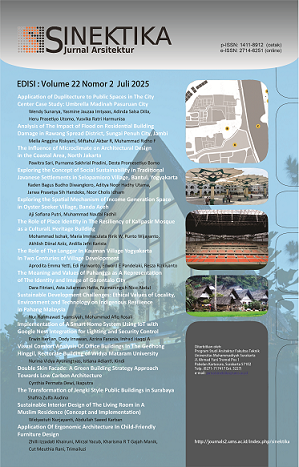Double Skin Façade: A Green Building Strategy Approach Towards Low Carbon Architecture
DOI:
https://doi.org/10.23917/sinektika.v22i2.5827Keywords:
Green Building Strategy, Energy, Carbon Emission, Double Skin FacadeAbstract
The emergence of global warming due to the increase in the amount of carbon emissions and greenhouse gas emissions is caused by one of the activities of the construction industry sector. Green building is one of the solutions that can help reduce energy consumption in buildings and carbon emissions in the building life cycle. Double Skin Façade (DSF) is one of the green building strategies that can be applied to new and existing buildings. This study aims to determine the type of DSF used in the field and how DSF can affect the energy consumption of buildings. This research uses a narrative review method that focuses on the application of the DSF strategy, how the mechanism works on the type of DSF used. The results show that the use of DSF is able to reduce HVAC energy loads in buildings in various types of climates. Stack effect as a key capability of DSF is able to create airflow in the air gap so as to stimulate air movement which in turn can reduce the use of HVAC in buildings. This shows that the DSF strategy is one of the green building strategies that has great potential to be developed in the future.
Downloads
References
Alhazzaa, K. (2021). Double Skin Façade and Potential Integration with Other Building Environmental. March.
Catto Lucchino, E., Gennaro, G., Favoino, F., & Goia, F. (2022). Modelling and validation of a single-storey flexible double-skin façade system with a building energy simulation tool. Building and Environment, 226(June), 109704. https://doi.org/10.1016/j.buildenv.2022.109704
Chatwani, N., Prajapat, K., & Meena, P. K. (2018). Reducing CO 2 emission through Green Building design. March.
Dewi, C. P. (2013). Double Skin Façade Strategy In Reducing Cooling Energy Demand For Energy Efficiency. National Central University.
Flores Larsen, S., Rengifo, L., & Filippín, C. (2015). Double skin glazed façades in sunny Mediterranean climates. Energy and Buildings, 102, 18–31. https://doi.org/10.1016/j.enbuild.2015.05.019
GhaffarianHoseini, A., GhaffarianHoseini, A., Berardi, U., Tookey, J., Li, D. H. W., & Kariminia, S. (2016). Exploring the advantages and challenges of double-skin facądes (DSFs). Renewable and Sustainable Energy Reviews, 60, 1052–1065. https://doi.org/10.1016/j.rser.2016.01.130
Ioannidis, Z., Rounis, E. D., Athienitis, A., & Stathopoulos, T. (2020). Double skin façade integrating semi-transparent photovoltaics: Experimental study on forced convection and heat recovery. Applied Energy, 278(July), 115647. https://doi.org/10.1016/j.apenergy.2020.115647
Joe, J., Choi, W., Kwak, Y., & Huh, J. H. (2014). Optimal design of a multi-story double skin facade. Energy and Buildings, 76, 143–150. https://doi.org/10.1016/j.enbuild.2014.03.002
Lai, F., Zhou, J., Lu, L., Hasanuzzaman, M., & Yuan, Y. (2023). Green building technologies in Southeast Asia: A review. Sustainable Energy Technologies and Assessments, 55(November 2022), 102946. https://doi.org/10.1016/j.seta.2022.102946
Liao, B., & Li, L. (2022). How can green building development promote carbon emission reduction efficiency of the construction industry?——Based on the dual perspective of industry and space. Environmental Science and Pollution
Research, 29(7), 9852–9866. https://doi.org/10.1007/s11356-021-16380-2
Liu, K., & Leng, J. (2022). Quantitative research on embodied carbon emissions in the design stage: a case study from an educational building in China. Journal of Asian Architecture and Building Engineering, 21(4), 1182–1192. https://doi.org/10.1080/13467581.2022.2046003
Lops, C., Di Loreto, S., Pierantozzi, M., & Montelpare, S. (2023). Double-Skin Façades for Building Retrofitting and Climate Change: A Case Study in Central Italy. Applied Sciences (Switzerland), 13(13). https://doi.org/10.3390/app13137629
Naddaf, M. S., & Baper, S. Y. (2023). The role of double-skin facade configurations in optimizing building energy performance in Erbil city. Scientific Reports, 13(1), 1–18. https://doi.org/10.1038/s41598-023-35555-0
Preet, S., Mathur, J., & Mathur, S. (2022). Influence of geometric design parameters of double skin façade on its thermal and fluid dynamics behavior: A comprehensive review. Solar Energy, 236(November 2021), 249–279. https://doi.org/10.1016/j.solener.2022.02.055
Rattedatu, I., Yulinawati, H., & Rahmiyati, L. (2023). Analysis of the application of technology in reducing carbon dioxide (CO2) emissions at two high schools in West Jakarta. IOP Conference Series: Earth and Environmental Science, 1263(1). https://doi.org/10.1088/1755-1315/1263/1/012026
Tao, Y., Fang, X., Chew, M. Y. L., Zhang, L., Tu, J., & Shi, L. (2021). Predicting airflow in naturally ventilated double-skin facades: theoretical analysis and modelling. Renewable Energy, 179, 1940–1954. https://doi.org/10.1016/j.renene.2021.07.135
Unluturk, M. S., & Kazanasmaz, Z. T. (2024). Integration of Daylight Use and Analysis in Double Skin Facades: A Literature Review. Gazi University Journal of Science , 37(2), 520–544. https://doi.org/10.35378/gujs.1243933
Vaglio, J., Patterson, M., & Hooper, S. (2010). Emerging Applications and Trends of Double-Skin Facades. International Conference on Building Envelope Systems and Technologies (ICBEST) 2010 in Vancouver, 5. http://enclos.com/assets/docs/Insight01-Chapter03-Emerging_Applications_and_Trends_of_Double-Skin_Facades.pdf
Wong, P. C. (2008). Ventilasi alami in double-skin façade design for office buildings in hot and humid climate. The University of New South Wales.
Xu, L., & Ojima, T. (2007). Field experiments on natural energy utilization in a residential house with a double skin façade system. Building and Environment, 42(5), 2014–2023. https://doi.org/10.1016/j.buildenv.2005.07.026
Zhou, Y., & Herr, C. M. (2023). A Review of Advanced Façade System Technologies to Support Net-Zero Carbon High-Rise Building Design in Subtropical China. Sustainability (Switzerland), 15(4). https://doi.org/10.3390/su15042913
Downloads
Submitted
Accepted
Published
Issue
Section
License
Copyright (c) 2025 Sinektika: Jurnal Arsitektur

This work is licensed under a Creative Commons Attribution-NonCommercial 4.0 International License.











